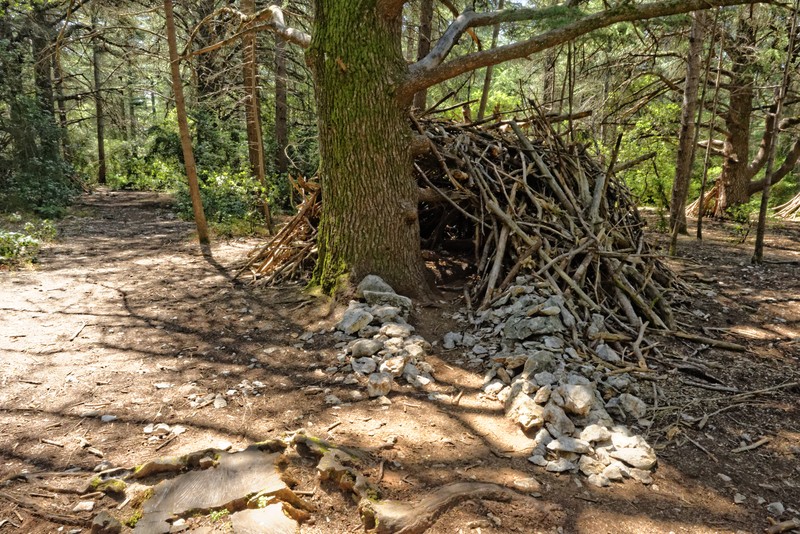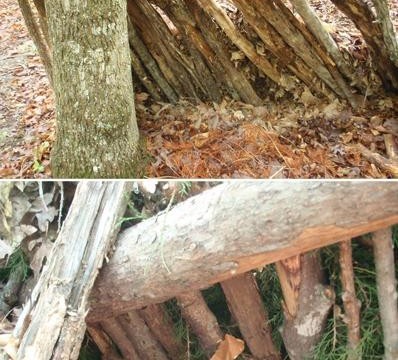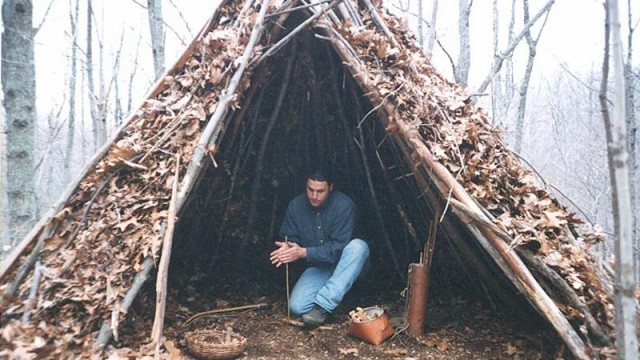When night is falling and the temperatures are falling with it, your first and only priority should be establishing a shelter that's going to keep you warm all night. If it's going to rain or snow, you should take that into account. Below you'll learn about which shelters will be useful in a variety of situations.
Lean-To
The lean-to is one of the simplest and most frequently constructed primitive shelters. It can be set up in less than an hour with a variety of materials. This basic, one-sided design will give you a haven from wind and rain that the wilderness might throw at you.Securely support a long, stout pole between two trees. Cover one side with poles, brush or branches. Then, heap leaves, grasses, palm fronds, or any other vegetation that is available on top. This shelter has two main flaws: 1) it doesn’t hold in heat well; 2) If the wind or rain changes direction you’ll no longer be sheltered. Think of it as a house with only one wall and half of a roof. It offers little in the way of insulation; and merely deflects wind and reflects the heat of the nearby fire.
Leaf Hut
The leaf hut is a two-sided, wedge-shaped lean-to with much better weatherproofing and insulating qualities. To build one, select a long, sturdy pole 9 to12 feet long. Prop it up in the fork of a tree; or set it on a rock, stump, or two forked prop sticks. Then, cover the sides of the pole with tree branches to act as ribs. These are placed at an angle along both sides of the ridge pole.Place the ribs close together so that your hut covering won’t fall through. Next, heap vegetation over the framework (this can be anything that traps air, including grass, ferns, moss, pine needles, brush, or pine boughs). Two to 3 feet of vegetation covering all sides of the shelter is enough to keep you dry inside. Finally, fill the inside of the hut with a thick pile of vegetation for your bedding.
Wicki-Up
The wicki-up is a bit like a small tipi made from poles, brush and vegetation. This shelter can be found across the globe, but has been most frequently documented in the American Southwest. Thicker brush, grass, and leaf coverings along with a steeper roof can make this shelter suitable for climates with occasional rain. A broader, squattier structure covered with light brush can give you a shady, ventilated shelter for hot, dry climates.Collect several dozen poles, some with forks at the top. Lock a few of these forks together to build a freestanding tripod. Then lay the other poles around to create the tipi frame. Finish with the vegetation layer. If the wicki-up is large enough, and the vegetation covering the roof is wet or green material, it may be safe enough to risk lighting a tiny fire inside.
Desert Tarp
This “double roofed” shelter dates back centuries among desert cultures, particularly in northern Africa and the Middle East, but it finally found widespread fame through the last century’s military survival training. To get started with this shelter, you’ll need two tarps and several dozen feet of rope. Find or dig your own low spot in the ground. Lay one of your tarps out over the low spot and drive each of your stakes at one corner of the tarp.Tie your tarp tightly to the stakes, and then tie the other tarp into place – so that it leaves one foot of air space between the two tarps. You can also fold over a larger tarp to create the two layers. Tie the tops of the four stakes to your four anchors, which can be stakes, rocks, logs or any other strong anchoring object.
Snow Cave
A snow cave may be the only shelter option in areas with deep snow. This is typically the most dangerous shelter to create, as the inhabitants could suffer from low oxygen or even be buried alive in a ceiling collapse.Snow selection is a critical part to the snow caves safe performance. Select a deep, solid snow bank or drift. Dig into the side of it, forming a tunnel into a low spot. This is the “cold well”, which is a place where the colder air can fall and collect. Then dig up and over creating a shelf or platform to sleep on. This should be the highest part of the shelter. Dig a small hole about 6 inches in diameter somewhere in the roof for ventilation, especially if you plan on blocking the entrance with a doorway of backpack or big snow chunk.
Round Lodge
The round lodge is a hybrid from many cultures. Part tipi, part wicki-up, and influenced by many architectural styles, a round lodge can block wind, rain, cold, and sun. It is structured like a tipi, with the addition of a solid doorway.These typically have a smoke hole through the roof, and can accommodate a tiny fire for heat and light. This shelter can be thatched with grass or mats; or it can be buried with a thick coat of leaf litter. Lodge styles like this abounded in the historic and prehistoric American west. This architecture worked equally well in wetter climates, and was used in pre-Roman Britain.
Bough Bed
This is not a shelter by itself, but it makes an outstanding addition to any other shelter type. To make a bough bed, you can use leaves, grass, evergreen boughs, or other plant material. Cedar and pine boughs are common enough in many places, but fir boughs make the softest bed. For the bed frame, roll up two logs, side by side and about 3 feet apart. Make sure they are longer than you are tall.Fill the void between the logs by laying down the boughs, several at a time. Dead, dry leaves or dead grasses can be a great addition if you have them. In snowy conditions, you’ll just have to stick with the boughs. Make the mattress so thick that you are at least 6 inches from the frozen ground or snow surface when lying down. Keep adding armloads of boughs or other vegetation if the mattress compresses too much or isn’t warm enough.
Images via Outdoor Life / Tim MacWelch
Staying warm is your first priority. If you know it's going to rain or the wind is really bad, then establishing a roof or wall should be a major priority, too. These shelters are great because they cover a variety of needs.
If you are in a desert or tropical area, you may not need a shelter for warmth, but to stay cool, so a shelter from the sun is what you should be building. Analyze your situation when deciding on your shelter.
Remember, you may only have one chance to get it right so you'd better make it count.
If you liked this information, you can check more shelters, which can be found at Outdoor Life.


